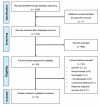Proximal Hamstring Tendinopathy: A Systematic Review of Interventions
- PMID: 33842025
- PMCID: PMC8016446
- DOI: 10.26603/001c.21250
Proximal Hamstring Tendinopathy: A Systematic Review of Interventions
Abstract
Background: Proximal hamstring tendinopathy affects athletic and non-athletic populations and is associated with longstanding buttock pain. The condition is common in track and field, long distance running and field-based sports. Management options need to be evaluated to direct appropriate clinical management.
Purpose/hypothesis: To evaluate surgical and non-surgical interventions used in managing proximal hamstring tendinopathy.
Study design: Systematic review.
Methods: Electronic databases were searched to January 2019. Studies (all designs) investigating interventions for people with proximal hamstring tendinopathy were eligible. Outcomes included symptoms, physical function, quality of life and adverse events. Studies were screened for risk of bias. Reporting quality was assessed using the Cochrane Risk of Bias Tool (Randomized Controlled Trials [RCT]) and the Joanna Briggs Institute Checklist (Case Series). Effect sizes (Standard mean difference or Standard paired difference) of 0.2, 0.5 and 0.8 were considered as small, medium and large respectively. Overall quality of evidence was rated according to GRADE guidelines.
Results: Twelve studies (2 RCTs and 10 case series) were included (n=424; males 229). RCTs examined the following interventions: platelet-rich plasma injection (n=1), autologous whole-blood injection (n=1), shockwave therapy (n=1) and multi-modal intervention (n=1). Case series included evaluation of the following interventions: platelet-rich plasma injection (n=3), surgery (n=4), corticosteroid injection (n=2), multi-modal intervention + platelet-rich plasma injection (n=1). Very low-level evidence found shockwave therapy was more effective than a multi-modal intervention, by a large effect on improving symptoms (-3.22 SMD; 95% CI -4.28, -2.16) and physical function (-2.42 SMD; 95% CI-3.33, -1.50) in the long-term. There was very low-level evidence of no difference between autologous whole-blood injection and platelet-rich plasma injection on physical function (0.17 SMD; 95% CI -0.86, 1.21) to (0.24 SMD; 95% CI -0.76, 1.24) and quality of life (-0.04 SMD; 95%CI -1.05, 0.97) in the medium-term. There was very low-quality evidence that surgery resulted in a large reduction in symptoms (-1.89 SPD; 95% CI -2.36, -1.41) to (-6.02 SPD; 95% CI -8.10, -3.94) and physical function (-4.08 SPD; 95%CI -5.53, -2.63) in the long-term.
Conclusions: There is insufficient evidence to recommend any one intervention over another. A pragmatic approach would be to initially trial approaches proven successful in other tendinopathies.
Level of evidence: Level 2a.
Keywords: buttock pain; hamstring tendon; surgery; tendinopathy.
Conflict of interest statement
The authors have no conflicts of interest to declare.
Figures
Similar articles
-
Autologous growth factor injections in chronic tendinopathy.J Athl Train. 2014 May-Jun;49(3):428-30. doi: 10.4085/1062-6050-49.3.06. Epub 2014 May 19. J Athl Train. 2014. PMID: 24840581 Free PMC article.
-
Workplace interventions for increasing standing or walking for decreasing musculoskeletal symptoms in sedentary workers.Cochrane Database Syst Rev. 2019 Nov 17;2019(11):CD012487. doi: 10.1002/14651858.CD012487.pub2. Cochrane Database Syst Rev. 2019. PMID: 31742666 Free PMC article.
-
Corticosteroid and other injections in the management of tendinopathies: a review.Clin J Sport Med. 2011 Nov;21(6):540-1. doi: 10.1097/01.jsm.0000407929.35973.b9. Clin J Sport Med. 2011. PMID: 22064721
-
The Effectiveness of Platelet-Rich Plasma in the Treatment of Tendinopathy: A Meta-analysis of Randomized Controlled Clinical Trials.Am J Sports Med. 2017 Jan;45(1):226-233. doi: 10.1177/0363546516643716. Epub 2016 Jul 21. Am J Sports Med. 2017. PMID: 27268111
-
Surgery for patellar tendinopathy (jumper's knee).Cochrane Database Syst Rev. 2019 Sep 23;9(9):CD013034. doi: 10.1002/14651858.CD013034.pub2. Cochrane Database Syst Rev. 2019. PMID: 31546279 Free PMC article.
Cited by
-
Extracorporeal Shockwave Therapy for Tendinopathies Around the Hip and Pelvis: A Systematic Review.HSS J. 2025 Apr 23:15563316251332189. doi: 10.1177/15563316251332189. Online ahead of print. HSS J. 2025. PMID: 40292269 Free PMC article. Review.
-
Current and future advances in practice: tendinopathies of the hip.Rheumatol Adv Pract. 2024 Apr 10;8(2):rkae022. doi: 10.1093/rap/rkae022. eCollection 2024. Rheumatol Adv Pract. 2024. PMID: 38601140 Free PMC article. Review.
-
Magnetic Resonance Imaging With a Novel Hip Flexion Scanning Position for Diagnosing Proximal Hamstring Tendinopathy.Orthop J Sports Med. 2024 Sep 25;12(9):23259671241265130. doi: 10.1177/23259671241265130. eCollection 2024 Sep. Orthop J Sports Med. 2024. PMID: 39328883 Free PMC article.
-
Lower extremity ultrasound-guided interventions: tendon, ligament, and plantar fascia.Skeletal Radiol. 2023 May;52(5):991-1003. doi: 10.1007/s00256-022-04212-4. Epub 2022 Nov 3. Skeletal Radiol. 2023. PMID: 36326878 Review.
-
Ultrasound-guided Musculoskeletal Interventional Procedures Around the Hip: A Practical Guide.J Ultrason. 2023 Feb 28;23(92):15-22. doi: 10.15557/JoU.2023.0003. eCollection 2023 Jan. J Ultrason. 2023. PMID: 36880006 Free PMC article.
References
-
- Proximal hamstring tendinopathy-overview of the problem with emphasis on the surgical treatment. Lempainen L., Sarimo J., Mattila K., Orava S. 2009Oper Tech Sports Med. 17(4):225–228. doi: 10.1053/j.otsm.2009.12.016. - DOI
-
- Puranen J., Orava S. American Journal of Sports Medicine. 5. Vol. 16. ;: The hamstring syndrome: a new diagnosis of gluteal sciatic pain; pp. 517–521. - PubMed
Publication types
LinkOut - more resources
Full Text Sources
Other Literature Sources
Research Materials





